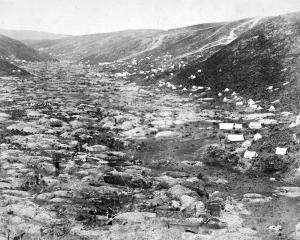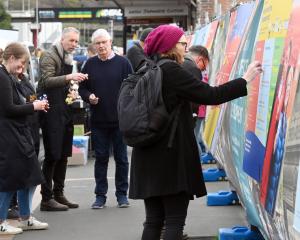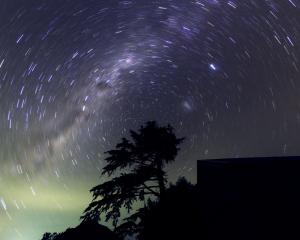But Coast-to-Coast champion Steve Gurney is planning an expedition in which one member will do just that: wear the clothing and use the equipment - mostly - that was considered first rate 120 years ago.
He will be attired in a tweed woollen jacket and pants, oilskin (oiled cotton) jacket and overtrousers for the worst of the norwest rain - and, to ward off those sub-zero temperatures while camping near the snowline, he will try to sleep in a woollen blanket sewn into a kind of sleeping bag, covered by an oilskin bivvy bag.
Steve Moffatt will be this walking, climbing, frequently shivering museum piece. He's a 60-year-old commercial flower grower, grandfather and adventure-racing competitor from Halswell, on the outskirts of Christchurch, who has a liking for the history of adventuring.
"There are some lovely stories about amazing things that people have done and that's what I would like to tell," Moffatt says while preparing for the Aoraki climb, scheduled to start next week.
The climb they plan to re-enact is one of the many unsuccessful attempts North Canterbury mountaineers Marmaduke Dixon, a farmer, and George Mannering, a banker, made to be the first on the summit of Aoraki.
In December 1890 - four years before the first successful ascent of New Zealand's highest mountain - Dixon and Mannering reached their highest point, a point about 40m below the icy summit of Aoraki, which was 3764m above sea level until more than 10 million cu m of rock and ice fell off in 1991, reducing its height by 10m.
The Irish clergyman William Spotswood Green, and Emil Boss and Ulrich Kaufmann, of Switzerland, were, in 1882, the first to try to reach the summit. They all but succeeded.
But they had pioneered what has become the standard route on the mountain and the one followed by Mannering and Dixon: up the Haast Ridge from the Tasman Glacier, up the Linda Glacier, up the Summit Rocks to the summit ice cap.
Today, however, most parties take a ski-plane to the Grand Plateau at the foot of the Linda, partly because the dramatic shrinkage of the Tasman Glacier has made the lower Haast Ridge a nasty scramble.
Green's trip was an expedition from the other side of the Earth. Mannering and Dixon, too, faced a difficult journey.
The first Hermitage hotel was built in 1884, but, beyond the train from Christchurch to South Canterbury, the horse-drawn transport over rough tracks was arduous and the crossing of the Hooker River dangerous until a wire rope and cage were installed.
On his first trip to the area in 1886, Mannering, with his cousin C. D. Fox, explored briefly up Haast Ridge, then drifted off course. Despite this failure, Mannering was hooked.
Mostly with Dixon, he made five more trips to the Mt Cook range, and on the last occasion, in 1893, they even used homemade skis fashioned from the blades of a reaper machine, to cope with soft snow on the plateau.
Their companion on the ski-assisted trip was Tom Fyfe, a brilliant rock-climber who on Christmas Day in 1894 reached the summit of Aoraki by a new route, the North Ridge, with Jack Clarke and George Graham.
Mannering and Dixon's 1890 expedition was more than just a climbing trip; they carted wooden canoes with them which they used to cross the Tasman River pre-climb, and then to paddle downriver, across Lake Pukaki to the Waitaki River system, to the railway bridge north of Oamaru, from where they caught the train back to Christchurch.
It is this multi-sport adventure, 1890s-style, that caught the eye of Gurney and Moffatt, following on from an earlier epic journey.
Moffatt first put his liking for period adventurer's kit into action in 2008. He and Gurney re-enacted the 1889/90 summer-holidays trip of Moffatt's great-great-uncle George Park and Park's brother James, from Hokitika to Lyttelton by foot and in wooden canoes.
The Parks floated, carried and paddled their canoes up the Taramakau River, over Harper Pass, and down the Hurunui River, where James had to pull out at the Hurunui hotel with a broken boat. George carried on to the coast and, using a small sail, continued south on the sea. Arguably the first Coast-to-Coast event, the trip took 13 days.
Moffatt found one of the original canoes and had a replica made. Frankie weighed 40kg. Gurney used a 19kg inflatable kayak.
Frankie suffered a few dings but has been patched up ready for the Aoraki trip. Gurney, who is going ultra-modern, will be paddling a kevlar sea kayak. And he'll chat on a satellite phone, fix their position on a GPS, wear the latest merino woollen clothing, a down or synthetic fleece jacket, and synthetic waterproof/ breathable parka and pants.
He will climb with crampons attached to his rubber-soled boots, while Moffatt copes with just the old-style hobnails and tricounis on his leather-soled boots.
A Clydesdale horse and cart will take them the last stretch of the journey to the Tasman River, from where, like Mannering and Dixon, they will float across to the start of their walk to the mountain's base.
After the climb, they will paddle and sail down the rivers, hydro lakes and canals to a bridge across the lower Waitaki.
Their climbing companions will be guide Gavin Lang; adventure cameraman Scott Simper, who will record the expedition for a film to be made; and camera assistant Hugh Logan, a veteran mountaineer, alpine historian, and former head of the Department of Conservation.
A short film of the Harper Pass trip was a finalist in the 2008 Mountain Film Festival at Wanaka.
Moffatt and Gurney say they are not mountaineers, but they have climbed a few peaks. Gurney has been up Mt Aspiring. And they completed an alpine club training course.
A big challenge for Moffatt is that he will use only nailed boots for grip instead of attaching crampons for safety on steep sections of hard snow and ice.
This old technique is based on cutting snow and ice steps, so he will also use a single 1940s straight-pick ice-axe, instead of an ice-axe and ice-hammer - both with curved picks - designed to hook into the surface.
It is likely he, Gurney and Lang will be three on one rope, and, in a concession to safety, Moffatt will use a modern harness, rather than tying a loop of rope around his waist.
"I've got people I want to come back to," Moffatt says.
He and Gurney have debated whether they will try for the summit if conditions permit. Gurney - perhaps not surprisingly, given his nine Coast-to-Coast wins - is keen, Moffatt's not. Gurney is worried about the safety of separating from Moffatt for part of the climb.
"We are having meaningful discussions," says Moffatt, "but I'm not going to climb to the top of Mt Cook. If I can get to where those boys got to, then I will be absolutely delighted. But I have said to Gurney he can climb to the top."
Moffatt is not the first to try retro-style climbing. The enduring mystery of whether George Mallory and Andrew Irvine might have reached the summit of Mt Everest in 1924 and died on the descent - 19 years before Sir Edmund Hillary and Tenzing Norgay were credited with the first ascent - has inspired others to climb with straight picks and hobnails.
A movie that opened in the United States in August, The Wildest Dream: Conquest of Everest, features Conrad Anker and Leo Houlding retracing Mallory's and Irvine's supposed route. Part of the filming has them in gear modelled on 1920s kit.
And in New Zealand, guides Lang and Whitney Thurlow and a client last year prepared to celebrate the centenary of Mt Aspiring's first ascent with a retro-style climb on the original route in tweeds and hobnails - although with modern crampons. However, a week of "screaming" winds dashed their plans, Lang says .
"I'm not a history geek, but I do have a lot of respect and curiosity for the old-school way of doing things."
Gurney says the Aoraki trip was not inspired by the Mallory-Irvine re-enactment, which he hadn't even heard of.
"We don't want to do a re-enactment like so many do on television where they drive up in their four-wheel drives and say, 'Well actually those guys came from over there and went past here and up to that place'. We actually want to do it as they would have, to get the full experience."
And that full experience might yet take Frankie the canoe - and Gurney's kevlar craft - across Cook Strait, in the wake of George and brother William Park. Aoraki is part two on a list of five pioneer adventures.












